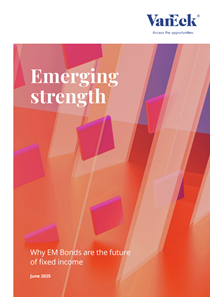Introduction
Many Australian investors’ fixed income portfolios do not include an allocation to emerging markets (EM) bonds. Over the past 25 years EM governments have gone from being in deficit to running up surpluses while developed market (DM) governments have been accruing deficits. This change has resulted in a shift in the origin of bond crises since the turn of the millennium.
Fixed income portfolios have yet to reflect this new reality. We think EM bonds are the future of fixed income. Because of the idiosyncrasies between the nations included in the EM universe and the nuances between the different types of bonds available, we think an active, unconstrained approach, like the one employed by VanEck’s Emerging Income Opportunities Active ETF (EBND), is an ideal way for investors to access this important asset class.
We launched EBND, our flagship EM bond strategy, on ASX five years ago. The ETF is designed to invest in all EM bonds: hard-currency sovereign, local-currency sovereign, and hard-currency corporate bonds. To call the last five years in markets as tumultuous understates the swings experienced. Yet despite the fund being launched into the COVID lockdowns and then navigating Russia’s invasion of Ukraine war, and a property crisis in China, EBND was the best performing fixed income ETF on ASX over the past five years. The fund is also a top performer among its EM Bond peers, including other EM Blend funds (which invest in local and hard currency) and local or hard currency only EM funds.
When considering the asset class, using EBND’s benchmark which was subject to the crises noted above but without any active management, it has outperformed major DM global bond markets. It is therefore surprising that EM bonds remain under owned. It is either a misunderstanding of the different risk-return profile since the turn of the century or the challenge of access.
Download the full paper
